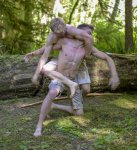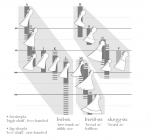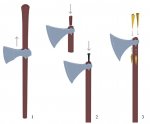The ax is one the three main Viking Period weapons for one-on-one combat. Roughly a third of Norse warriors seem to use each: ax, sword, and spear. For mass combat and its battle formations, most use the spear, at least initially before throwing it. When switching to one-on-one usually the ax or sword finds use.

In the Early and Middle Viking Periods, the Norse ax is typically the bol-øx, the same ax as the tool for chopping wood, literally the ‘tree trunk’ ax. An other style of utility ax is the ‘beard ax’ whose axhead has the blade hanging downward.
These axes are known for destroying the opponents shield.
Around the Late Viking Period, a battleax that is specifically designed for combat comes into use, called the ‘broad ax’, breið-øx. Its axhead has an edge that is much longer, but also lighter, being thinner.
Any of these three axhead styles can be two-handed with a ‘high shaft’ or one-handed ‘low shaft’.
Simple Weapons
øx, háskepta (two-hand ax) 1d6 slashing, versatile
øx, lágskepta (one-hand ax) 1d6 slashing, light, thrown
Martial Weapons
breiðøx, háskepta (two-hand broadax) 1d8 slashing, versatile
breiðøx, lágskepta (one-hand broadax) 1d6 slashing, light, finesse, thrown






